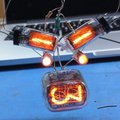![]() Dan Maloney12:00 PM
Dan Maloney12:00 PM
OK folks, welcome to the first Hack Chat of 2023! I'm Dan, and as usual I'll be moderating today along with Dusan -- I think, anyway. Today we're welcoming Danel Herrington to the chat as we talked about machining with electricity.
![]() Cooper12:00 PM
Cooper12:00 PM
But it cuts well open loop
Arthur Mercer joined the room.12:00 PM
![]() Dan Maloney12:00 PM
Dan Maloney12:00 PM
Daniel, are you online yet?
![]() Dusan Petrovic12:01 PM
Dusan Petrovic12:01 PM
Hi Dan. welcome everyone!
![]() Daniel Herrington12:01 PM
Daniel Herrington12:01 PM
I am here!
![]() Cooper12:01 PM
Cooper12:01 PM
Welcome Daniel. Thank you for coming. I've been interested in your company for some time
![]() Dan Maloney12:01 PM
Dan Maloney12:01 PM
Hi Dule, Happy belated New Year!
![]() John12:01 PM
John12:01 PM
Welcome Daniel
![]() Dan Maloney12:02 PM
Dan Maloney12:02 PM
Hi Daniel, welcome aboard. Can you tell us a little about what Voxel does, and about your involvement with ECM?
![]() Dusan Petrovic12:02 PM
Dusan Petrovic12:02 PM
@Dan Maloney - Thanks, all the best to you too
![]() Daniel Herrington12:04 PM
Daniel Herrington12:04 PM
Sure, happy to. I started Voxel in 2015 and at the time it was just me in a garage building a piece of electrochemical machining equipment from scratch. We have been focused exclusively on electrochemical machining (ECM) and its variants including PECM, STEM, etc. Early on, we were mostly doing R&D funding by federal government research contracts but lately we have started making production parts for people in aerospace, medical, and energy industries.
![]() Daniel Herrington12:05 PM
Daniel Herrington12:05 PM
Although I am most familiar with the electrochemical varieties of metal machining, we use or compete with EDM (electrical discharge machining) all the time.
![]() Dan Maloney12:05 PM
Dan Maloney12:05 PM
I love a good garage start-up story...
![]() Cooper12:05 PM
Cooper12:05 PM
Is there a reason you were drawn ECM versus EDM?
![]() Daniel Herrington12:06 PM
Daniel Herrington12:06 PM
ECM seemed like it had more untapped potential. It has the ability to be much faster and produce better surfaces than EDM but is not used as widely. I thought that if I could figure out why and improve the technology, maybe ECM could be used more frequently.
![]() Dan Maloney12:07 PM
Dan Maloney12:07 PM
Seems like there's a huge established base of EDM technology already. I've only recently heard of ECM myself.
![]() Cooper12:07 PM
Cooper12:07 PM
Why do you think it is not as widely used if the surface finish is superior and the process can be faster?
![]() Dan Maloney12:08 PM
Dan Maloney12:08 PM
Bit that I've exactly got my finger on the pulse of the industry, of course
![]() Dan Maloney12:08 PM
Dan Maloney12:08 PM
*Not that
![]() Cooper12:08 PM
Cooper12:08 PM
I know the East has been developing ECM since the cold war, but I rarely hear of it
![]() Daniel Herrington12:08 PM
Daniel Herrington12:08 PM
Like many technologies, the core ideas are old. The first ECM companies started in the 60s. In the US that began with a company called Annocut but there were a number of Russian pioneers in this space as well.
![]() PatientLightning12:08 PM
PatientLightning12:08 PM
How did you find where the state of the art was, in order to get up to speed?
I've been trying to learn about EDM but there isn't a lot of DIY
epictaters joined the room.12:09 PM
![]() Daniel Herrington12:09 PM
Daniel Herrington12:09 PM
But as CNC milling got better and the end mill materials improved, it started to replace some ECM applications. Also, some ECM companies mis-managed the waste stream (dumped into rivers in Ohio...bad idea), so that turned some people off.
![]() Thomas Shaddack12:10 PM
Thomas Shaddack12:10 PM
How much does ECM differ from EDM?
![]() Cooper12:10 PM
Cooper12:10 PM
How does voxel deal with hazardous waste(e.g. Chromium 6)? This is one reason why I switched to EDM. Much more environmentally friendly on the maker-level
![]() Daniel Herrington12:11 PM
Daniel Herrington12:11 PM
So I think that has stymied some innovation in this space. But we are starting to see new interested in ECM processes because metal alloys are continuing to get harder to machine, surface finish requirements are pretty challenging, and ECM can be a cheaper way to make the parts so if you have high part volumes, it is worth exploring.
![]() Daniel Herrington12:12 PM
Daniel Herrington12:12 PM
When I started the business, I read countless research papers. I got access to the NC State University library and just read whatever I could find. You can find some academic papers that describe at least the principles of the technology. But to figure out what really goes on in industry, you have to try yourself or see if you can corner an engineer from an EDM or ECM company.
![]() Dan Maloney12:12 PM
Dan Maloney12:12 PM
Chromium? Nasty stuff, that. Is that a byproduct of ECM on stainless steel? Or in chromium used as an electrolyte or something?
![]() John12:13 PM
John12:13 PM
I would check Google Scholar to see if there are any microorganisms or enzymes than can reduce chromium +6 into something less hazardous. Back in academia, that was a trend for dealing with difficult chemistry problems
![]() Cooper12:13 PM
Cooper12:13 PM
Yes, @Dan Maloney chromium 6 is a result from ECM of stainless(or any chromium containing alloy).
![]() RichardCollins12:13 PM
RichardCollins12:13 PM
What kinds of projects would you like to do?
![]() Cooper12:14 PM
Cooper12:14 PM
CR6 can have it's energy level reduced to CR3 by citric acid, but one would still have to filter it out of the electrolyte using activated carbon or similar.
![]() Dan Maloney12:15 PM
Dan Maloney12:15 PM
Wow -- I'd have thought there was so little Cr is stainless that it wouldn't matter much. But then again, it only takes a little hexavalent chromium to ruin your day, so...
![]() Daniel Herrington12:15 PM
Daniel Herrington12:15 PM
In EDM, you create a spark to thermally ablate the material. It blasts the material away and makes micro-scale craters in the process. The spark happens sequentially across the surface of the electrode so if your electrode is twice as big, it takes twice as long (double the surface area for the spark to traverse). In ECM, we are dissolving metal with an anodic process. We are converting metal into metal oxide or hydroxide and liberating it from the surface - basically removing material atom-by-atom. It is a similar mechanism to electropolishing but at a much faster rate with much more current.
![]() Cooper12:15 PM
Cooper12:15 PM
Yes, exactly Dan.
![]() Thomas Shaddack12:15 PM
Thomas Shaddack12:15 PM
or it could be reduced with iron(II) sulfate.
![]() Daniel Herrington12:15 PM
Daniel Herrington12:15 PM
The hexavalent chrome is definitely an issue but there are many known ways to reduce it and the wastewater treatment industry does it all the time.
![]() Cooper12:16 PM
Cooper12:16 PM
true Thomas, though citric acid may be easier for the average maker to get
![]() Daniel Herrington12:16 PM
Daniel Herrington12:16 PM
Iron sulfate, sodium metabisulfite, and other methods can reduce hex chrome to trivalent chrome
![]() Cooper12:16 PM
Cooper12:16 PM
Daniel, how to you control for cathode corrosion? I know it should be prevented during cutting, but how many cycles can you feasibly get out of a tool?
![]() Daniel Herrington12:17 PM
Daniel Herrington12:17 PM
Hex chrome is a challenge because it stays in solution so you cannot filter it. But if you can reduce it chemically to trivalent chrome, you can precipitate that metal and filter it with standard filtration processes.
![]() John12:18 PM
John12:18 PM
Has anyone attempted to precipitate it and remove it via centrifugation? I do not know the solubility of the ECM products verses pH, but that could be handy
![]() Daniel Herrington12:18 PM
Daniel Herrington12:18 PM
When you run the ECM process, you are splitting water at the surface of the cathode (tool). This means that you produce hydrogen gas and hydroxide (OH-). That hydroxide drives the pH to be very basic. So, for one, the cathode needs to withstand a basic environment. Aluminum, for example, will just dissolve.
![]() Cooper12:19 PM
Cooper12:19 PM
I've seen that one first hand lol. Poor aluminum tools
![]() Daniel Herrington12:19 PM
Daniel Herrington12:19 PM
But otherwise the bigger risk for the cathode is that you deposit material on the surface (since this is like a reverse electroplating operation). In practice, this doesn't really happen because the chemical conditions are not favorable and you are usually flushing electrolyte through the gap pretty aggressively.
dcpub joined the room.12:20 PM
![]() anfractuosity12:20 PM
anfractuosity12:20 PM
With ECM, do you vary the voltage, to cut at different rates? And what voltages/currents do you use?
![]() Dan Maloney12:20 PM
Dan Maloney12:20 PM
One thing that strikes me about ECM (and to some extent sinker EDM) is that making the tool seems like a huge investment in time. So there must be a kind of inverse value proposition, where the cost of tooling has to be spread over a big production run of ECM-produced parts to make it worth it. Is that true?
![]() John12:20 PM
John12:20 PM
Stainless steel has always worked for me, and it comes in useful electrode shapes via dispensing syringes
![]() Daniel Herrington12:20 PM
Daniel Herrington12:20 PM
To John's question - once you convert hex chrome to trivalent chrome, you can remove it via centrifuge if the pH is right. There is a company called Tridex (now owned by Glebar) that makes electrochemical grinding machines (ECG) and that is how they remove their waste.
![]() John12:21 PM
John12:21 PM
EDM Die tools are not terribly expensive now because graphite blocks have gotten cheaper, and it is very easy to machine
![]() RichardCollins12:21 PM
RichardCollins12:21 PM
Is the hydroxide produced part of machining aluminum? Is the electrical part important or only a way to split water?
![]() RichardCollins12:21 PM
RichardCollins12:21 PM
Chromium carbonate is insoluble.
![]() Daniel Herrington12:21 PM
Daniel Herrington12:21 PM
Yes, voltage is a major control variable in ECM. We often run a voltage from 5-40V and the current levels may be 50-100 A/cm2. So this means that you can quickly get into thousands of amps for a hand-sized part.
![]() Thomas Shaddack12:22 PM
Thomas Shaddack12:22 PM
Thought. Could a tip of a thin wire scanned over the object used as a tool? I am thinking about EDM as alternative to etching circuitboards, and it may even have potential for 3d machining for eg. turning a broken carbide tool bit into a custom shaped threading tap.
![]() RichardCollins12:22 PM
RichardCollins12:22 PM
Is the voltage and current only mainly to split water, and the actual cutting is chemical action of hydroxide on the metal?
![]() Cooper12:23 PM
Cooper12:23 PM
I believe ECM is too difficult to localized for 3D machining if you're not running a 3D die.
![]() Daniel Herrington12:23 PM
Daniel Herrington12:23 PM
Dan - you are correct. ECM (at least today - but we are working on it!) doesn't make sense for low volume work. It just costs too much to design, manufacture, and iterate on the electrode and process. So often we are making parts in the thousands to millions per year.
![]() Piotr12:23 PM
Piotr12:23 PM
@Dan Maloney for EDM you use easy to machines material like graphite, brass or copper so even cheap hobby level milling machine can do that.
![]() Cooper12:23 PM
Cooper12:23 PM
Daniel, can you use graphite as an electrode material?
![]() Daniel Herrington12:23 PM
Daniel Herrington12:23 PM
I wish we could make our electrodes out of graphite because it would be much easier and cheaper to make them but, we can't.
![]() PatientLightning12:24 PM
PatientLightning12:24 PM
does graphite have a poor reaction like aluminum?
![]() Cooper12:24 PM
Cooper12:24 PM
Why is this?
![]() RichardCollins12:25 PM
RichardCollins12:25 PM
Most all the electrode chemistry can be done from first principles. So experimenting can refine the calibration, but you do not need to iterate by experiments over a huge parameter space. I used the carbon electrode from batteries when I started.
![]() Arthur Mercer12:25 PM
Arthur Mercer12:25 PM
What would be a common part produced by ECM that would be familiar?
![]() RichardCollins12:26 PM
RichardCollins12:26 PM
@Arthur Mercer Good question
![]() Daniel Herrington12:26 PM
Daniel Herrington12:26 PM
Thomas - yes, people have made a "CNC mill ECM" machine before but it is very slow. ECM is fast when you can use a tool with lots of surface area. That is why you don't see much ECM single-hole drilling. Instead, that is usually doing with hole-pop EDM, laser, or conventional drilling. But if you need to make a big array of holes, we would machine hundreds of them simultaneously with ECM and that is how we get the speed advantage.
![]() Piotr12:26 PM
Piotr12:26 PM
So as far as I understand ECM vs EDM:
+not usage on electrode (could produce massive parts)
-electrode must be made from SS
-problems with chrome
![]() Daniel Herrington12:28 PM
Daniel Herrington12:28 PM
Arthur - if you have bought a Norelco shaver from Philips, all of those shaver caps (the three round parts with slots and holes) are made via PECM. I think they make around 100 million of those a year.
![]() Cooper12:29 PM
Cooper12:29 PM
Daniel, why can graphite not be used for an ECM electrode? is it a similar chemical issue to aluminum?
![]() John12:29 PM
John12:29 PM
I would like to see EDM get popular for DIY people. EDM can cut stainless steel, which can then be used for making ECM tooling yourself.
![]() Arthur Mercer12:30 PM
Arthur Mercer12:30 PM
What is the "P" in PCM?
![]() Arthur Mercer12:30 PM
Arthur Mercer12:30 PM
PECM
![]() Thomas Shaddack12:30 PM
Thomas Shaddack12:30 PM
I love the aspect of zero forces on the tool. That means a high accuracy positioning system can be made without requirements for high stiffness that would have to absorb the machining forces without deforming.
![]() Piotr12:31 PM
Piotr12:31 PM
@Daniel Herrington what is a maximum volume removal speed you can reach with ECM?
![]() RichardCollins12:31 PM
RichardCollins12:31 PM
@Cooper graphite is porous and soft, it has its places. You really ought not talk about ECM as one thing, use of electric currents for machining, plating, drilling, facing, chemical treatment -- is old technology, almost older than electricity itself.
![]() Daniel Herrington12:31 PM
Daniel Herrington12:31 PM
Cooper - I believe that graphite is not conductive enough. EDM operates at 100 or 100s of volts and low amperage. We are the inverse with ECM - low voltage and high amperage. So I think to get enough current through a graphite tool, we would have to apply a lot of voltage and the combination of that would be a lot of heat.
![]() Cooper12:33 PM
Cooper12:33 PM
@Thomas Shaddack that was my thought too when I first started into ExM. The thought that you could convert a low force motion system, i.e. a 3D printer, was enticing. I've found that I was unable to get sufficient accuracy from general purpose ECM tools however
![]() Daniel Herrington12:33 PM
Daniel Herrington12:33 PM
Arthur - the P in PECM can sometimes mean "pulsed" (thats how we refer to it) and some people say it means "precision". Ultimately, all it really means is that we are getting the electrode very close to the workpiece (around 20um or .001") and that is what enables the level of resolution in PECM.
![]() Piotr12:33 PM
Piotr12:33 PM
Thomas I also think that this is a game changer. Whatever cost of tooling it is, you can always find it profitable with enough volume
![]() Cooper12:33 PM
Cooper12:33 PM
Daniel - That makes sense, thank you
![]() Thomas Shaddack12:35 PM
Thomas Shaddack12:35 PM
Slow cheap machines can be clustered. See 3d printing farms. The same with different tool heads could become ECM farms. And revert to printing as needed. Modular high-adaptability architecture.
![]() Daniel Herrington12:35 PM
Daniel Herrington12:35 PM
It is not uncommon for our electrodes to cost thousands or tens of thousands of dollars (once you include all of the development). We can make them to be very intricate because they will not be consumed. Unless the process fails and then we get a spark (a really bad EDM machine) and destroy both the tool and the workpiece. But all of this still works out when you can amortize that cost over thousands or millions of parts.
![]() RichardCollins12:35 PM
RichardCollins12:35 PM
Conductivity of aluminum is 37.7 MegaSiemens per meter. Tungsten is 17.9 MSpm. Graphite is about -.25 MSpm
https://en.wikipedia.org/wiki/Electrical_resistivity_and_conductivity
![]() Thomas Shaddack12:36 PM
Thomas Shaddack12:36 PM
Can you electrodeposit metal onto the damaged tool? Or laser-weld a little blob of metal? And then machine it to shape again?
![]() Cooper12:36 PM
Cooper12:36 PM
Thomas - yes, maybe. I would not use ECM if you did not have a sophisticated electrolyte management system on hand. It is too dangerous when it comes to poisoning people. Voxel has a closed loop electrolyte system that would prevent this
![]() Piotr12:36 PM
Piotr12:36 PM
stainless steel 1,32 Mspm
![]() Cooper12:37 PM
Cooper12:37 PM
Daniel, do you expect metal additive to make your tooling costs lower?
![]() Thomas Shaddack12:37 PM
Thomas Shaddack12:37 PM
We worked with chromate-sulfuric acid when cleaning glass. Cr(VI) is not THAT dangerous.
![]() Daniel Herrington12:37 PM
Daniel Herrington12:37 PM
Thomas - I like the idea of a farm of cheap, but slow, ECM machines.
![]() RichardCollins12:37 PM
RichardCollins12:37 PM
@Thomas Shaddack A patient man is capable of anything he puts his mind to.
![]() Daniel Herrington12:37 PM
Daniel Herrington12:37 PM
You can repair tools but often it is easier or cheaper just to replace them.
![]() Thomas Shaddack12:38 PM
Thomas Shaddack12:38 PM
I like the idea of rapidly reconfigurable machine arrays. Additive, subtractive, measuring, change tool head and on you go.
![]() Thomas Shaddack12:38 PM
Thomas Shaddack12:38 PM
Swarm approach.
![]() Daniel Herrington12:38 PM
Daniel Herrington12:38 PM
Cooper - we have used metal AM pretty extensively for tooling and it is pretty interesting. But it doesn't have good enough surface finish and you can't make features small enough for many of our needs. So that means you have to post-machine the 3D printed part. Sometimes that is worth it, but sometimes it is just cheaper to make it from scratch without 3D printing a near-net shape.
![]() Guru-san12:38 PM
Guru-san12:38 PM
What does the tool/electrode physically looks like on an ECM machine?
![]() RichardCollins12:39 PM
RichardCollins12:39 PM
https://www.voxelinnovations.com/ has some nice pictures
He only has one video at https://www.youtube.com/@VoxelInnovations/videos
![]() Thomas Shaddack12:40 PM
Thomas Shaddack12:40 PM
Thought. 3d-print a tool mold from resin. Add a conductive surface. Electrodeposit metal on it. Use that as a tool for ECM.
![]() Thomas Shaddack12:40 PM
Thomas Shaddack12:40 PM
Electroforming can also replicate silicone imprints. One of its historical uses was counterfeiting of antiquities.
![]() Daniel Herrington12:40 PM
Daniel Herrington12:40 PM
Guru-san - the tool is basically the inverse of the part you are trying to make. But on top of that, you have to build a manifold or nozzle to force flow between the tool and workpiece. It isn't exactly the inverse (due to current field lines, how the electrolyte flows, the vector of the electrode motion) but that is the general idea.
![]() Cooper12:40 PM
Cooper12:40 PM
@Thomas Shaddack the main problem with reconfiguring from ECM is the electrolyte. It tends to get everywhere unless you're extremely careful. Electrolyte has ruined my 3D printer's motion system before
![]() Cooper12:41 PM
Cooper12:41 PM
Rust everywhere
![]() Daniel Herrington12:41 PM
Daniel Herrington12:41 PM
Yes - the electrolyte is a pain! We have destroyed lots of things with electrolyte.
![]()
 OK folks, welcome to the first Hack Chat of 2023! I'm Dan, and as usual I'll be moderating today along with Dusan -- I think, anyway. Today we're welcoming Danel Herrington to the chat as we talked about machining with electricity.
OK folks, welcome to the first Hack Chat of 2023! I'm Dan, and as usual I'll be moderating today along with Dusan -- I think, anyway. Today we're welcoming Danel Herrington to the chat as we talked about machining with electricity. But it cuts well open loop
But it cuts well open loop Daniel, are you online yet?
Daniel, are you online yet? Hi Dan. welcome everyone!
Hi Dan. welcome everyone!
 Welcome Daniel. Thank you for coming. I've been interested in your company for some time
Welcome Daniel. Thank you for coming. I've been interested in your company for some time Hi Dule, Happy belated New Year!
Hi Dule, Happy belated New Year!![]() Welcome Daniel
Welcome Daniel Hi Daniel, welcome aboard. Can you tell us a little about what Voxel does, and about your involvement with ECM?
Hi Daniel, welcome aboard. Can you tell us a little about what Voxel does, and about your involvement with ECM? @Dan Maloney - Thanks, all the best to you too
@Dan Maloney - Thanks, all the best to you too

 I love a good garage start-up story...
I love a good garage start-up story... Is there a reason you were drawn ECM versus EDM?
Is there a reason you were drawn ECM versus EDM?
 Seems like there's a huge established base of EDM technology already. I've only recently heard of ECM myself.
Seems like there's a huge established base of EDM technology already. I've only recently heard of ECM myself. Why do you think it is not as widely used if the surface finish is superior and the process can be faster?
Why do you think it is not as widely used if the surface finish is superior and the process can be faster? Bit that I've exactly got my finger on the pulse of the industry, of course
Bit that I've exactly got my finger on the pulse of the industry, of course *Not that
*Not that I know the East has been developing ECM since the cold war, but I rarely hear of it
I know the East has been developing ECM since the cold war, but I rarely hear of it
 How did you find where the state of the art was, in order to get up to speed?
How did you find where the state of the art was, in order to get up to speed?
![]() How much does ECM differ from EDM?
How much does ECM differ from EDM? How does voxel deal with hazardous waste(e.g. Chromium 6)? This is one reason why I switched to EDM. Much more environmentally friendly on the maker-level
How does voxel deal with hazardous waste(e.g. Chromium 6)? This is one reason why I switched to EDM. Much more environmentally friendly on the maker-level

 Chromium? Nasty stuff, that. Is that a byproduct of ECM on stainless steel? Or in chromium used as an electrolyte or something?
Chromium? Nasty stuff, that. Is that a byproduct of ECM on stainless steel? Or in chromium used as an electrolyte or something?![]() I would check Google Scholar to see if there are any microorganisms or enzymes than can reduce chromium +6 into something less hazardous. Back in academia, that was a trend for dealing with difficult chemistry problems
I would check Google Scholar to see if there are any microorganisms or enzymes than can reduce chromium +6 into something less hazardous. Back in academia, that was a trend for dealing with difficult chemistry problems Yes, @Dan Maloney chromium 6 is a result from ECM of stainless(or any chromium containing alloy).
Yes, @Dan Maloney chromium 6 is a result from ECM of stainless(or any chromium containing alloy). What kinds of projects would you like to do?
What kinds of projects would you like to do? CR6 can have it's energy level reduced to CR3 by citric acid, but one would still have to filter it out of the electrolyte using activated carbon or similar.
CR6 can have it's energy level reduced to CR3 by citric acid, but one would still have to filter it out of the electrolyte using activated carbon or similar. Wow -- I'd have thought there was so little Cr is stainless that it wouldn't matter much. But then again, it only takes a little hexavalent chromium to ruin your day, so...
Wow -- I'd have thought there was so little Cr is stainless that it wouldn't matter much. But then again, it only takes a little hexavalent chromium to ruin your day, so...
 Yes, exactly Dan.
Yes, exactly Dan.![]() or it could be reduced with iron(II) sulfate.
or it could be reduced with iron(II) sulfate.
 true Thomas, though citric acid may be easier for the average maker to get
true Thomas, though citric acid may be easier for the average maker to get
 Daniel, how to you control for cathode corrosion? I know it should be prevented during cutting, but how many cycles can you feasibly get out of a tool?
Daniel, how to you control for cathode corrosion? I know it should be prevented during cutting, but how many cycles can you feasibly get out of a tool?
![]() Has anyone attempted to precipitate it and remove it via centrifugation? I do not know the solubility of the ECM products verses pH, but that could be handy
Has anyone attempted to precipitate it and remove it via centrifugation? I do not know the solubility of the ECM products verses pH, but that could be handy
 I've seen that one first hand lol. Poor aluminum tools
I've seen that one first hand lol. Poor aluminum tools
 With ECM, do you vary the voltage, to cut at different rates? And what voltages/currents do you use?
With ECM, do you vary the voltage, to cut at different rates? And what voltages/currents do you use? One thing that strikes me about ECM (and to some extent sinker EDM) is that making the tool seems like a huge investment in time. So there must be a kind of inverse value proposition, where the cost of tooling has to be spread over a big production run of ECM-produced parts to make it worth it. Is that true?
One thing that strikes me about ECM (and to some extent sinker EDM) is that making the tool seems like a huge investment in time. So there must be a kind of inverse value proposition, where the cost of tooling has to be spread over a big production run of ECM-produced parts to make it worth it. Is that true?![]() Stainless steel has always worked for me, and it comes in useful electrode shapes via dispensing syringes
Stainless steel has always worked for me, and it comes in useful electrode shapes via dispensing syringes
![]() EDM Die tools are not terribly expensive now because graphite blocks have gotten cheaper, and it is very easy to machine
EDM Die tools are not terribly expensive now because graphite blocks have gotten cheaper, and it is very easy to machine Is the hydroxide produced part of machining aluminum? Is the electrical part important or only a way to split water?
Is the hydroxide produced part of machining aluminum? Is the electrical part important or only a way to split water? Chromium carbonate is insoluble.
Chromium carbonate is insoluble.
![]() Thought. Could a tip of a thin wire scanned over the object used as a tool? I am thinking about EDM as alternative to etching circuitboards, and it may even have potential for 3d machining for eg. turning a broken carbide tool bit into a custom shaped threading tap.
Thought. Could a tip of a thin wire scanned over the object used as a tool? I am thinking about EDM as alternative to etching circuitboards, and it may even have potential for 3d machining for eg. turning a broken carbide tool bit into a custom shaped threading tap. Is the voltage and current only mainly to split water, and the actual cutting is chemical action of hydroxide on the metal?
Is the voltage and current only mainly to split water, and the actual cutting is chemical action of hydroxide on the metal? I believe ECM is too difficult to localized for 3D machining if you're not running a 3D die.
I believe ECM is too difficult to localized for 3D machining if you're not running a 3D die.
![]() @Dan Maloney for EDM you use easy to machines material like graphite, brass or copper so even cheap hobby level milling machine can do that.
@Dan Maloney for EDM you use easy to machines material like graphite, brass or copper so even cheap hobby level milling machine can do that. Daniel, can you use graphite as an electrode material?
Daniel, can you use graphite as an electrode material?
 does graphite have a poor reaction like aluminum?
does graphite have a poor reaction like aluminum? Why is this?
Why is this? Most all the electrode chemistry can be done from first principles. So experimenting can refine the calibration, but you do not need to iterate by experiments over a huge parameter space. I used the carbon electrode from batteries when I started.
Most all the electrode chemistry can be done from first principles. So experimenting can refine the calibration, but you do not need to iterate by experiments over a huge parameter space. I used the carbon electrode from batteries when I started.![]() What would be a common part produced by ECM that would be familiar?
What would be a common part produced by ECM that would be familiar? @Arthur Mercer Good question
@Arthur Mercer Good question
![]() So as far as I understand ECM vs EDM:
So as far as I understand ECM vs EDM:
 Daniel, why can graphite not be used for an ECM electrode? is it a similar chemical issue to aluminum?
Daniel, why can graphite not be used for an ECM electrode? is it a similar chemical issue to aluminum?![]() I would like to see EDM get popular for DIY people. EDM can cut stainless steel, which can then be used for making ECM tooling yourself.
I would like to see EDM get popular for DIY people. EDM can cut stainless steel, which can then be used for making ECM tooling yourself.![]() What is the "P" in PCM?
What is the "P" in PCM?![]() PECM
PECM![]() I love the aspect of zero forces on the tool. That means a high accuracy positioning system can be made without requirements for high stiffness that would have to absorb the machining forces without deforming.
I love the aspect of zero forces on the tool. That means a high accuracy positioning system can be made without requirements for high stiffness that would have to absorb the machining forces without deforming.![]() @Daniel Herrington what is a maximum volume removal speed you can reach with ECM?
@Daniel Herrington what is a maximum volume removal speed you can reach with ECM? @Cooper graphite is porous and soft, it has its places. You really ought not talk about ECM as one thing, use of electric currents for machining, plating, drilling, facing, chemical treatment -- is old technology, almost older than electricity itself.
@Cooper graphite is porous and soft, it has its places. You really ought not talk about ECM as one thing, use of electric currents for machining, plating, drilling, facing, chemical treatment -- is old technology, almost older than electricity itself.
 @Thomas Shaddack that was my thought too when I first started into ExM. The thought that you could convert a low force motion system, i.e. a 3D printer, was enticing. I've found that I was unable to get sufficient accuracy from general purpose ECM tools however
@Thomas Shaddack that was my thought too when I first started into ExM. The thought that you could convert a low force motion system, i.e. a 3D printer, was enticing. I've found that I was unable to get sufficient accuracy from general purpose ECM tools however
![]() Thomas I also think that this is a game changer. Whatever cost of tooling it is, you can always find it profitable with enough volume
Thomas I also think that this is a game changer. Whatever cost of tooling it is, you can always find it profitable with enough volume Daniel - That makes sense, thank you
Daniel - That makes sense, thank you![]() Slow cheap machines can be clustered. See 3d printing farms. The same with different tool heads could become ECM farms. And revert to printing as needed. Modular high-adaptability architecture.
Slow cheap machines can be clustered. See 3d printing farms. The same with different tool heads could become ECM farms. And revert to printing as needed. Modular high-adaptability architecture.
 Conductivity of aluminum is 37.7 MegaSiemens per meter. Tungsten is 17.9 MSpm. Graphite is about -.25 MSpm
Conductivity of aluminum is 37.7 MegaSiemens per meter. Tungsten is 17.9 MSpm. Graphite is about -.25 MSpm![]() Can you electrodeposit metal onto the damaged tool? Or laser-weld a little blob of metal? And then machine it to shape again?
Can you electrodeposit metal onto the damaged tool? Or laser-weld a little blob of metal? And then machine it to shape again? Thomas - yes, maybe. I would not use ECM if you did not have a sophisticated electrolyte management system on hand. It is too dangerous when it comes to poisoning people. Voxel has a closed loop electrolyte system that would prevent this
Thomas - yes, maybe. I would not use ECM if you did not have a sophisticated electrolyte management system on hand. It is too dangerous when it comes to poisoning people. Voxel has a closed loop electrolyte system that would prevent this![]() stainless steel 1,32 Mspm
stainless steel 1,32 Mspm Daniel, do you expect metal additive to make your tooling costs lower?
Daniel, do you expect metal additive to make your tooling costs lower?![]() We worked with chromate-sulfuric acid when cleaning glass. Cr(VI) is not THAT dangerous.
We worked with chromate-sulfuric acid when cleaning glass. Cr(VI) is not THAT dangerous.
 @Thomas Shaddack A patient man is capable of anything he puts his mind to.
@Thomas Shaddack A patient man is capable of anything he puts his mind to.
![]() I like the idea of rapidly reconfigurable machine arrays. Additive, subtractive, measuring, change tool head and on you go.
I like the idea of rapidly reconfigurable machine arrays. Additive, subtractive, measuring, change tool head and on you go.![]() Swarm approach.
Swarm approach.
 What does the tool/electrode physically looks like on an ECM machine?
What does the tool/electrode physically looks like on an ECM machine? https://www.voxelinnovations.com/ has some nice pictures
https://www.voxelinnovations.com/ has some nice pictures![]() Thought. 3d-print a tool mold from resin. Add a conductive surface. Electrodeposit metal on it. Use that as a tool for ECM.
Thought. 3d-print a tool mold from resin. Add a conductive surface. Electrodeposit metal on it. Use that as a tool for ECM.![]() Electroforming can also replicate silicone imprints. One of its historical uses was counterfeiting of antiquities.
Electroforming can also replicate silicone imprints. One of its historical uses was counterfeiting of antiquities.
 @Thomas Shaddack the main problem with reconfiguring from ECM is the electrolyte. It tends to get everywhere unless you're extremely careful. Electrolyte has ruined my 3D printer's motion system before
@Thomas Shaddack the main problem with reconfiguring from ECM is the electrolyte. It tends to get everywhere unless you're extremely careful. Electrolyte has ruined my 3D printer's motion system before Rust everywhere
Rust everywhere
![]()
 Dan Maloney
Dan Maloney
Discussions
Become a Hackaday.io Member
Create an account to leave a comment. Already have an account? Log In.